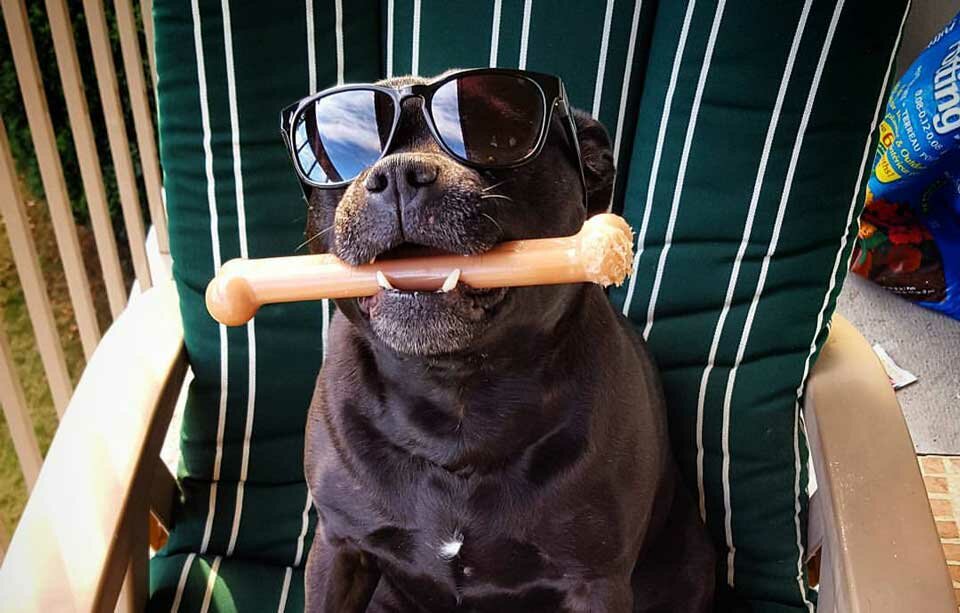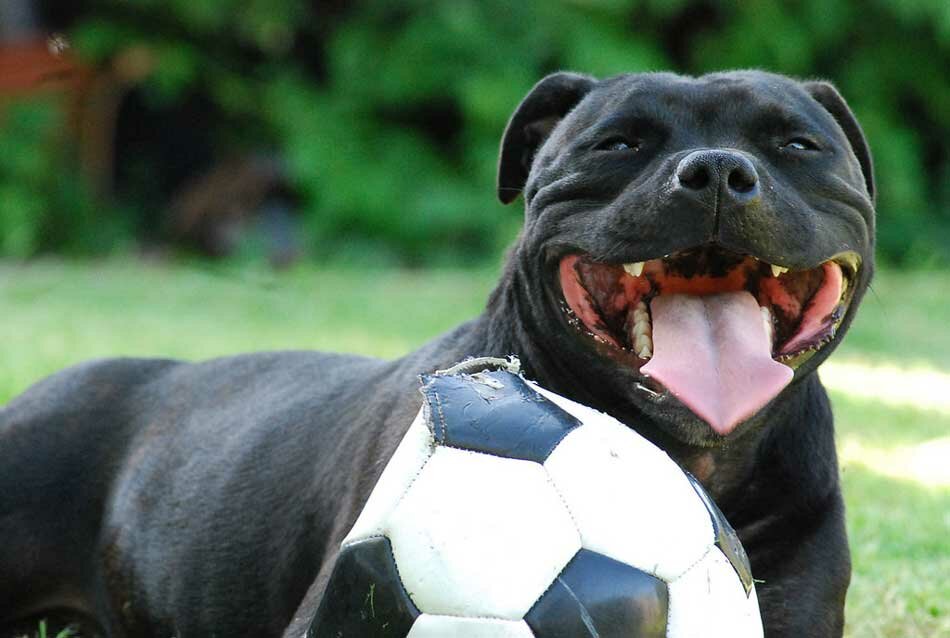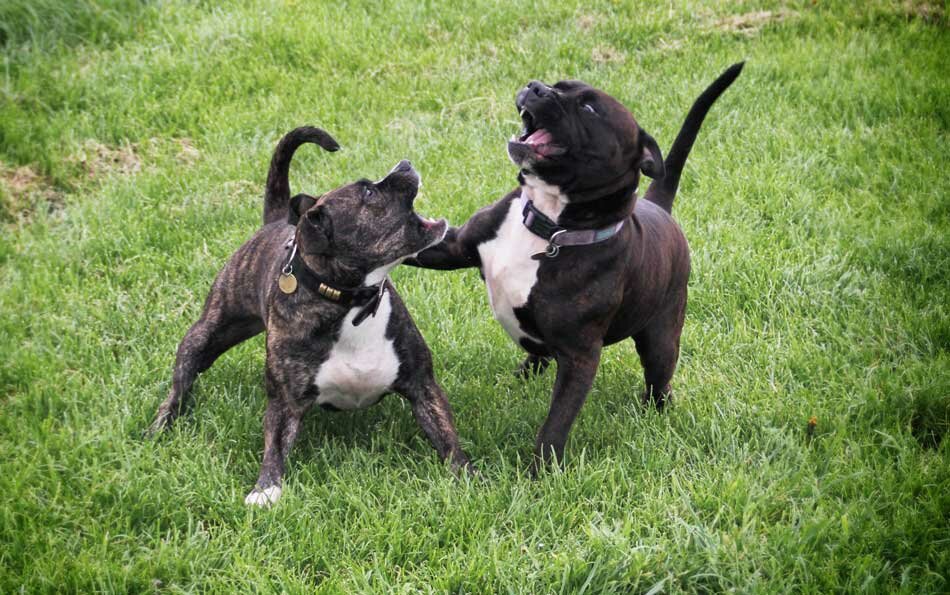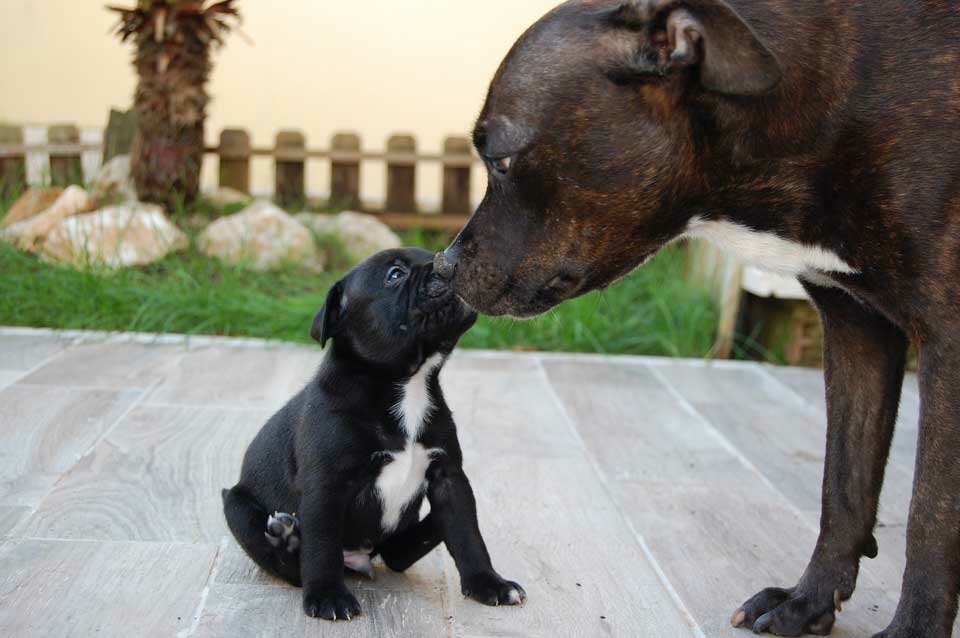 Staffies are my first love when it comes to dog breeds. I met my first Staffordshire Bull Terrier back in 1999 and absolutely knew I wanted one some day. In 2010 that day came when I brought home my Staffy girl Ruby. I knew to represent the breed as positively as I could I needed to train her to a very high level. What I discovered made me fall in love even more.
Staffies are my first love when it comes to dog breeds. I met my first Staffordshire Bull Terrier back in 1999 and absolutely knew I wanted one some day. In 2010 that day came when I brought home my Staffy girl Ruby. I knew to represent the breed as positively as I could I needed to train her to a very high level. What I discovered made me fall in love even more.
Are Staffies easy to train? As a whole Staffies are easy to train. The Staffordshire Bull Terrier is a highly intelligent, clever, and people focused dog. A Staffy’s eagerness to please their owner, and ability to focus on engaging activities can make training an easy and enjoyable experience.
This has been my experience training my Staffy girl. From a very early age I understood her potential from the eagerness she displayed and her ability to pick up commands fast. My approach to training was firm, calm, and always positive. This produced the best results.
In this post I will go over some simple training tips you can follow with Staffies. These tips have served me well as a first time Staffy owner, and provided a solid foundation for my dogs training. Let’s dig in!
How Smart Are Staffies?
As a general rule Staffies are very smart dogs. Despite one popular measurement of dog intelligence that ranks a Staffy as “Average Working/Obedience Intelligence” I believe this ranking system to be flawed. It doesn’t factor in the freethinking and clever aspects of the Staffy but instead measures blind obedience.
Anyone who has worked with a Staffy will attest to their intelligence and keen focus when engaged. You can see the wheels turning and anticipation for commands when immersed in interactions with their owner.
That being said the Staffordshire Bull Terrier can be free thinking and free willed to a fault. This doesn’t detract from them being a very smart dog, but it can add a layer of challenge to training. More on this in the next section.
My Staffy Ruby doing all her tricks
Are Staffies Hard to Train?
If you wonder, are staffies hard to train? Staffies are relatively easy to train. These dogs are quick learners and have an eagerness to please. Despite these good qualities, staffies are quite stubborn. To control their behavior and the challenges that they can present, it is crucial to start their training at a young age. Training a staffy puppy is much easier than training an adult.
Training Staffordshire bull terrier can also be difficult due to their natural strength. Regular training and socialization at their puppyhood help them learn and adapt to changes quickly. Use positive reinforcement. With guidance and patience, staffies can be trained easily.
Are Staffies Stubborn?
On average Staffies can be very stubborn. Staffordshire Bull Terriers are free thinking dogs with a will of their own at times. The stubborn streak in a Staffy is not a lack of intelligence, it is a need for them to be convinced to do something rather than told.
This can make training hard if you don’t find ways to communicate and engage a Staffy. Oftentimes you will see the wheels turning when giving a command to a Staffy. They will actively analyze whether they want to obey. A “what’s in it for me” mentality.
Overcoming the stubborn streak of Staffies can be quite easy however. I myself have done this with my Staffy, and the tips in this post are designed specifically to help guide your training. Communication and engagement are the driving force to make training a Staffy easy.
Why Training Staffordshire Bull Terrier is Necessary?
Training is an essential part of a dog’s life to balance their behavior, socialize them, and provide mental stimulation during different situations. Staffordshire bull terrier dogs are quick learners and relatively easy to train. Training these dogs from their puppyhood helps them to learn new things and adapt to different environments without struggling.
Obedience training, potty training, positive reinforcement, and relationship-building training help them to socialize and prevent developing destructive behaviors. Training also strengthens the bond between the owner and the dog.
How to Train a Staffordshire Bull Terrier?
If you wonder, how to train a Staffordshire bull terrier, follow the given steps:
- Obedience Training: Start with obedience training. Teach him to respond to the basic commands like stay, come, lie, sit, and heel.
- Use Positive Reinforcement: Giving rewards motivates the dog to do more. Positive reinforcement like treats, praise, or toys on the desired behavior helps them to understand to repeat the behavior.
- Socialize the Dog: Proper socialization is necessary to train a dog in how to act in front of different people and environments.
- Be Patient: Consistency and patience are the keys to training your dog according to your wish. Negative reinforcement allows them to behave opposite in the future. Try to be calm and patient while training your dog.
Provide Mental and Physical Stimulation: Increase their mental and physical stimulation by engaging them in exercise, puzzle toys, and playtime. staffy when to bark at strangers and defend against threats. Assess the dog’s temperament and be ready for any risks associated with training. Maintain ownership of your dog and prioritize safety in this matter.
How To Train A Staffordshire Bull Terrier – 10 Tips
These are some of the basic principles I established over the first years of owning my Staffy. Through some trial and error I found a great formula to work with my dog and raise an well balanced, obedient dog.
Keep Training Sessions Short
Training sessions with your Staffy should be fairly short. Anywhere between 15-20 minutes per session is the maximum amount of time you should dedicate. The reason for this being your dog will lose interest.
Puppies especially have short attention spans and will become disengaged with the training activity and want to move on. This is perfectly natural. 15 minutes per session per day will quickly add up over time.
When training my Staffy I would do 2-3 short sessions a day. Once in the morning, once in the evening, and on occasion an afternoon session when time permitted and she seemed willing. The progress made with these short sessions was incredible. Forcing things beyond 15 minutes became unproductive and sometimes frustrating to us both. Keep it short!
Keep Your Staffies Training Consistent
Training with your Staffy should be consistent. Routines and repetition with your dog is a guaranteed path to success. Make training a part of your daily regime with your Staffy. Set aside 15 minutes at least once a day to work on basic obedience and some fun tricks.
A daily practice will reinforce new learnings and keep things top of mind for you and your Staffy. Gaps in training will set your progress back. Making a daily routine for your Staffy’s learning will reap tremendous results in a fairly short period of time.
Keep Training Fun!
If there is one thing a Staffy responds well to, it’s fun! Keep training sessions fun and engaging for your dog. Make learning a game and have your Staffy become an eager and willing participant. This technique alone can overcome even the most stubborn Staffy.
Making training fun doesn’t necessarily mean getting your Staffy over excited. Fun can mean engaging and rewarding activities. Calm praise, regular rewards, and challenging but achievable tasks are a great time for Staffies.
Keep Training Positive
Staffies respond exceptionally well to positive reinforcement training. The eager to please nature of a Staffy lends itself very well to consistent praise and rewards for completed tasks. Praise and reward the smallest of victories. This approach keeps your Staffy wanting to learn and achieve more with every session.
Never use punishment while training. Yelling, shouting, hitting, or hard corrections are to be avoided. Training should be an experience both you and your Staffy look forward to doing together. Creating fear, stress and anxiety during training will undo any progress, and make the next sessions much more difficult.
When you find yourself getting to a point of frustration it’s time to stop. It is better to end a training session with little success than to reach a boiling point. End the session with a very simple task, reward your dog and come back to training when you are in a calm and positive state.
Keep Your Staffy In Good Shape
The health of your Staffy is vital for countless reasons, and training is just one of them. A healthy, energetic Staffy is ready to engage and participate in training sessions. When the health of your dog is not optimal it will be much harder for them to focus and engage.
Proper diet and supplementation for cognitive ability, as well as general health such as exercise are crucial for learning. Keep your Staffy in great health and training will be much easier.
When you Staffy is not feeling well on a certain day skip the training and focus on getting them back to optimal health. There is no need to push a dog to learn when they are ill or injured. Consult with your vet and allow your Staffy to have a day off.
Give Staffies An Early Start
Start training with your Staffy immediately. Day one training begins! This is true if you have a 9 week old puppy, or have adopted a 9 year old adult. Begin training right away. The sooner you begin to build a bond with your dog the better your success.
For puppies training can be as simple as learning what toys to chew, where to potty, and basic commands like sit. Work on this everyday. You would be amazed at how quickly a Staffy puppy will pick up new commands and guidance.
Always be patient with training, but especially in the early days. Developing the lines of communication and strengthening the bond with your dog will take some time. Little victories should always be celebrated and praised, and minor setbacks are allowed. There is always a chance for redemption tomorrow.
Give Your Staffy Enough Exercised

Training will be significantly easier when your Staffy is getting enough exercise. Staffies are very high energy dogs, and training can be difficult if your dog has a lot of pent up energy. Regular exercise for your Staffy makes training sessions more productive when they are able to focus.
I recommend doing training sessions following your daily walk. This was the approach I used with my Staffy and it worked significantly better than the days before she had some exercise. When a Staffy has pent up physical energy, having them focus mentally on training will be tedious. Exercise first, learning second.
Related Article – Do Staffies Need Lots Of Exercise? – 10 Staffy Activities
Give Your Staffy Mental Stimulation
Training is a mental exercise for your Staffy. Keeping this exercise stimulating is what your dog craves, and will help overcome any stubborn tendencies. Let’s face it, repeating the same “Sit, stay, down” commands dozens of times is boring. Important to learn, but boring.
Get creative with your training sessions. Work on different skills, provide challenges that are achievable yet require a little extra brain power or self control. Make training a game. Things like fetch can include commands like “Come, wait, release” for example.
Structured games with real world use cases for obedience are perfect to keep your Staffy mental stimulated. They won’t look at the activity as a boring training session, but as a super fun game with their best buddy.
Give Your Staffy Playmates

As much as we would like to take credit for our dog’s good behavior, spending time around other dogs is a tremendous learning opportunity for them. Dogs learn a ton of behavior from other dogs. How to play, interact, and behave as a pack are all picked up from other dogs.
Find your Staffy some regular playmates to interact with on a regular basis. This could be a friend or family member’s dog that you meet with a couple times a week to play in the yard.
Regular social interactions in a controlled and neutral environment will provide some great learning activities for your Staffy. One of the keys to having a well balanced dog is to ensure proper socialization is taking place on a consistent basis.
Give Staffies Rules And Boundaries
Dogs need leadership and structure. When there is a lack of rules and boundaries in a household oftentimes a dog will begin to engage in bad behaviors. These bad behaviors can lead to destructive, neurotic, or even potentially aggressive behaviors when left unchecked.
Give your Staffy clear set rules of the house. If you don’t want your dog to be on your bed. Teach them to stay off the bed. When you are cooking in the kitchen and don’t want your Staffy at your feed begging, teach them to stay out of the kitchen while you are cooking.
Whatever your house rules might be, make sure you make them clear and consistent. Giving your Staffy free rein of the home to do as they please is unsafe and unhealthy. Simple rules that are communicated will establish your leadership and provide structure to your dog.
A simple example I have with my Staffy is she is not allowed on the couch unless invited. Why you might ask? Well when I have guests over with drinks in hand, or I am eating in front of the T.V., having a Staffy bomb up on the couch will cause spills and accidents. Teaching her to wait for an invite eliminates the chance of these accidents.
Resources & Reviews – The Best Dog Training Courses, Books, & Tools
Are Staffies Hard To Potty Train?
Potty training a Staffy is not a matter of being hard or easy, it is a matter of approach. Setting your Staffy up for success and being proactive is the best tool you can use to potty train them. Patiences and routine are all important factors in potty training a Staffy.
Like any other training, potty training should follow some of the same principles mentioned above. Positive reinforcement, consistency, and making learning fun are all key elements to successfully potty training a Staffy.
I cover this topic in much more depth in the related article below . Here I talk about some of the proactive steps you can take, some great tips to speed up success, and common problems to address, monitor, and avoid.
Potty Training a Staffy Puppy
Like other dogs, potty training is not easy but is possible for a staffy puppy. Monitor the puppy and analyze behavior toward their natural instincts like sniffing or restlessness. This is the time when the puppy wants to be released. Take them outside the house after waking up, after meals, and before sleeping.
Make a consistent routine and take them to the same spot every time. Stay with them to ensure they go potty and pat them after doing their job. Use positive reinforcement and reward them every time they do it. Staffies are intelligent and respond quickly. Don’t get impatient and be consistent, helping the puppy to grasp the concept of potty training.
Related Article – Are Staffies Hard To House Train? – 9 Easy Potty Time Tips
How to Train a Staffy for Security?
If you worry, about how to train a staffy for personal protection, then don’t. Training a staffy for security personal protection requires a direct approach focused on obedience, socialization, and understanding the commands. Be patient with your dog and use positive reinforcement. Train them in basic commands like “sit”, “lie”, and ”heal”. Then train them to respond to protection commands like “bark”, and “leave it.”
Socialization plays a vital role in training for protection to prevent fear or aggression toward people or unfamiliar situations. Train your dog to adop to different environments.
How Do You Discipline A Staffy?
There are a few techniques you can use to discipline a Staffy. None of which include physical punishment, abuse, or fear based approaches. Techniques such as redirection, tonal voice sounds, time outs, and withholding attention are all effective forms of discipline for Staffies.
Various definitions of the word discipline include the word punishment, and for this use case I would avoid that term. Discipline for me is more about training to dissuade certain unwanted behaviors and reinforce wanted behaviors.
Dogs can misbehave at times. Shocking information I know, but it’s true. Finding the right approach to correcting behavior can make all the difference in the personality of your dog as they grow.
Harsh physical punishments and fear based approaches can create neurotic and anxious dogs. Positive reinforcement of good behaviors, and communication of unwanted behaviors through non abusive methods is the approach that has worked best for my Staffy.
Before I jump into my methods it’s important to mention when to apply discipline. Catching your dog in the act of bad behavior is a must. Minutes or even hours after the behavior has taken place is ineffective. The dog cannot connect the previous event to the current disapproval you display.
If your dog tore up the garbage, peed on the rug, or dug up your flower bed when you weren’t looking or weren’t at home. The window for discipline is gone. Catching them in the act will help them understand the connection between the unwanted behavior and your disapproval.
Using Your Voice – The Buzzer Sound
Using your voice is one of the most effective ways to discipline a Staffy when caught in the act. A sharp “Ah-Ah-Ah” sound can break them away from the unwanted behavior and grab their attention for you to follow up with a firm “No!”.
I call this my buzzer sound. Similar to a game show buzzer when a contestant gets a wrong answer. I have used this “AH!” sound on my Staffy from day one, and she knows that whatever she is doing I disapprove.
Redirection
Once I have used my buzzer sound and broken the unwanted behavior I will redirect my Staffy. This is most effective for things like chewing the wrong things, or digging around where they are not supposed to.
Redirecting to a wanted behavior like giving them a chew toy, or engaging them in a different activity will reinforce this wanted behavior and break them from the bad behavior.
Withhold Your Attention
Withholding attention by ignoring your dog after they have done something bad works especially well on Staffies. They are very people pleasing dogs and crave attention. When they play rough, or nip at your clothing, give them the buzzer noise and disengage with them.
By taking attention away from them after they are engaged with you they learn that this behavior results in no more play or attention. This technique works especially well for puppies that still bite and nip often. Break off engagement and ignore them for several minutes.
Time Out
Time outs are a last resort for me and are usually used when rambunctious behavior, or repeated buzzer noise and redirection are not effective. Placing your Staffy in a separate room to calm down for several minutes can be an effective way to teach.
Several minutes in a separate room can show them that rowdy or excited behavior is unwanted. That being said, if your dog has not been exercised for the day this is also your fault. Pent up energy will lead to such unwanted behavior, so being proactive with exercise may prevent rowdy behavior in the first place.
Never use a separate room or especially a crate as punishment. Physically forcing your dog into either of these environments, or shouting as you do so will create a negative association. Particularly with crates. Time outs should be calmly administered. Keep your cool and stoically remove your dog from the room and place them in another for some quiet time.
How Do You Socialize A Staffy?

As a general rule socializing a Staffy should take place in a relatively calm and neutral environment. Walks with friends or family member’s are a great way to introduce your Staffy to another dog, and monitored playdates in a yard or quiet off leash areas are ideal.
Dog parks can be too chaotic at times and may not be the best place for socializing a Staffy. A busy dog park is often filled with dogs that are not being monitored as closely by owners as they should. The over excited behaviors can be overwhelming for some dogs and lead to fights breaking out.
Play dates, walks, and calm greetings with other dogs in your neighborhood are very effective ways to socialize your Staffy. Allow your Staffy to interact with other dogs, but try to keep the excitement level manageable. Look for tense postures to avoid fights or challenges.
Conclusion

The Staffordshire Bull Terrier can be incredibly easy to train when approached correctly. Staffies respond extremely well to structure, leadership, positive reinforcement and fun. Keeping your Staffy engaged in learning by following the basic tips outlined in the post will set you and your dog up for great success.
To summarize these are the basic principles you should follow when training your Staffy:
- Keep Training Sessions Short
- Keep Your Staffies Training Consistent
- Keep Training Fun!
- Keep Training Positive
- Keep Your Staffy In Good Shape
- Give Staffies An Early Start
- Give Your Staffy Enough Exercised
- Give Your Staffy Mental Stimulation
- Give Your Staffy Playmates
- Give Staffies Rules And Boundaries
Be patient with your Staffy when training. Building lines of communication, respect, and understanding take time. A Staffy can learn very quickly when set up for success, so take this training time seriously.
Training never ends. Just because your puppy has managed to learn to sit, pee outside, and walk well on leash does not mean training is complete. Training with your Staffy is a daily, lifelong activity. This keeps them sharp, engaged, obedient, and stimulated each day which further strengthens the bond you have with your dog.
